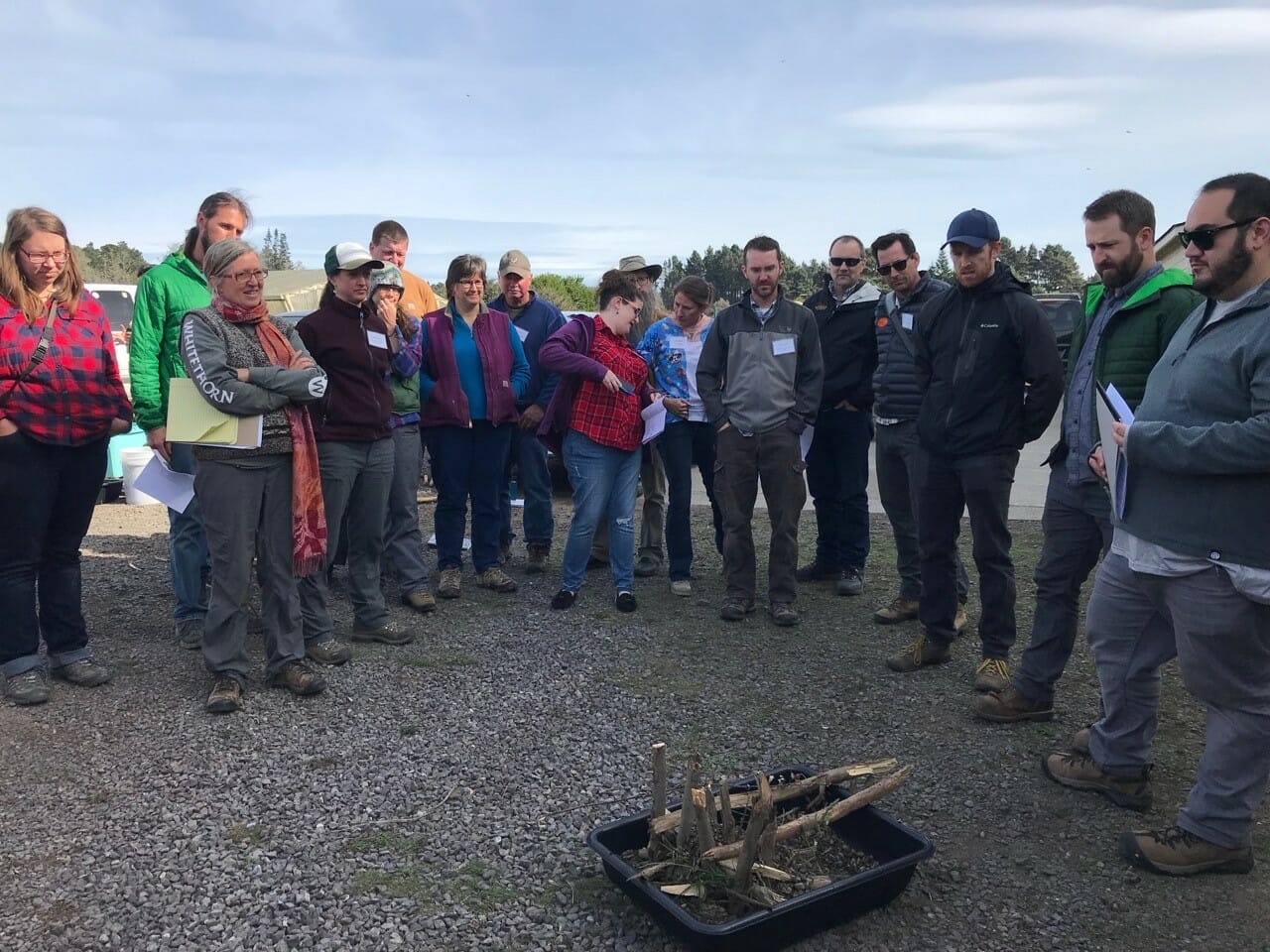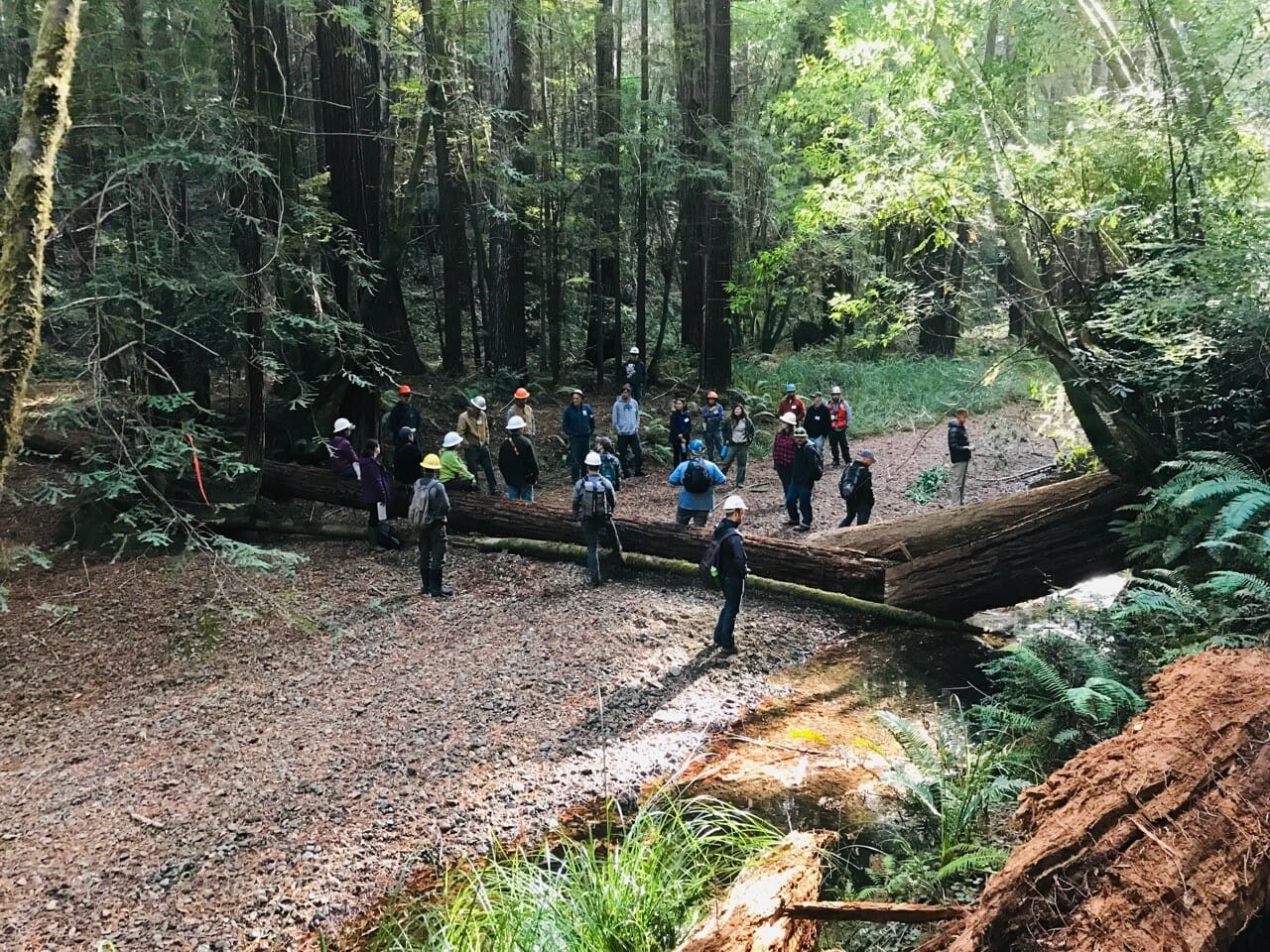Participants in the 2018 Large Wood Technical Field School, hosted by TU and the Salmonid Restoration Federation. Photo: Dana Stolzman, SRF
One of the biggest coldwater conservation challenges in the western U.S. is recovering coho salmon in California, the southernmost extent of the species’ historical range.
Coho, one of four species of salmon native to California, once teemed in coastal streams from Santa Cruz to the Oregon border. As recently as the 1940s there were an estimated 250,000 to a half-million coho in California. But 150 years of logging and other development, with virtually none of today’s environmental mitigation requirements, took their toll as stream habitat became ever more altered and degraded.
By 2009 there were only an estimated 500 coho adults returning to California waters to spawn. The species is now one of the rarest native fishes in the Golden State and is listed as endangered under state and federal laws.
Over the past two decades, however, the collective effort to bring back coho in California has made some progress, particularly in refinement of habitat restoration techniques which can deliver rapid and significant benefits for coho, coastal steelhead and other freshwater species. One technique — installation of large wood “structure” (mainly tree trunks and root balls) in streams — has proven highly effective.
TU’s North Coast Coho Project specializes in restoration projects which incorporate this technique. Some of TU’s Coho restoration partners, including the Salmonid Restoration Federation (SRF), also have worked to expand the placement of large wood structure in North Coast streams. This partnership has helped drive real on-the-ground improvements in habitat and fish migration — in 2017 alone, for example, the North Coast Coho Project installed about 725 pieces of large woody material in more than 11.5 miles of North Coast streams and removed or restructured three major fish migration barriers.
In recent years it became clear there was a growing demand for more information about best practices for installing large wood structure in streams. TU and SRF stepped up to meet this demand. The result was the first-ever Large Wood Technical Field School, held in Caspar, Calif., on Oct. 30 and 31.
A grant from the State Water Resources Control Board Timber Regulation and Forest Restoration Fund made the Field School possible. More than 50 participants successfully completed the curriculum, and TU and SRF proclaimed the event “a tremendous success.” (Read their press release here.)
The field school sold out months in advance—testament to the growing recognition that this restoration technique provides real benefits for habitat complexity and is an important tool in the Coho recovery campaign.

The Field School provided scientific and hands-on instruction for forestry and restoration professionals in both engineered and non-engineered large wood augmentation techniques. The participants included convening engineers, planners, heavy equipment operators, scientists and on-the-ground practitioners from diverse affiliations including tribes, forestry companies, consulting firms and regional, state and federal agencies.
Participants in the 2018 field school learned how to design and implement large wood restoration projects through identification of geomorphic conditions of a treatment stream and selection of appropriate implementation methods to achieve desired results. Each day included classroom lectures, hands-on activities, field demonstrations, project site tours and group discussion. The hands-on group activities included buoyancy and other engineering computations and the construction of large wood site scenarios in the classroom, as well as an on-site overview of heavy equipment implementation techniques. Additional topics included project site identification, project layout, and design considerations.
Anna Halligan, director of the North Coast Coho Project, said, “The first-ever Large Wood Technical Field School exceeded expectations in every way, especially in demand for participation and quality and breadth of the curriculum. For coho salmon in California, there is no time to lose. We have learned a lot about strategic placement of large wood structure in coastal creeks to restore and improve habitat for fish, and it is very important that all stakeholders working on coho recovery understand and utilize the most cost-effective and productive habitat restoration tools.”
Dana Stolzman, executive director of the SRF, said, “The high demand for the technical field school highlights both the efficacy of this kind of stream treatment and its utility for resource agencies, timber companies, and other key partners in the collaborative effort to recover the coho Salmon. We thank the State Water Resources Control Board Timber Regulation and Forest Restoration Fund and all the participating partners for their help in making this event a tremendous success. Now, we need to translate this know-how to even more on-the-ground habitat and stream-channel improvements.”
Presenters at the 2018 Large Wood Technical Field School were (view their presentations here):
- Chris Blencowe (Blencowe Watershed Management, Inc.): Accelerated Recruitment: Cost-effective Restoration Techniques for Enhancing Instream Habitat in California Coho Streams
- Ken Smith (Pacific Inland, Inc.): Selecting and Sourcing Trees for the Accelerated Recruitment Approach
- Mike Love and Rachel Shea (Michael Love and Associates, Inc.): Restoring Wood’s Essential Role in Controlling Channel Grade and Stability in Small Streams; How to Keep Your Wood from Floating Downstream: Interactive Computations for Stability of Large Wood Structures
- The California Conservation Corps: 30 Years in the Making: California Conservation Corps Instream Large Wood Restoration Techniques: Site Selection, Site Layout, and Design
- Tom Leroy (Pacific Watershed Associates, Inc.): Case Studies of Non-Engineered Wood Loading in Low Risk Environments: Identifying Project Objectives and Techniques
- Margie Caisley (California Department of Fish and Wildlife): When is a Large Wood Project a Success?
Nota bene: The Large Wood Field School Project was funded wholly or in part by the State Water Resources Control Board (State Water Board). The contents of this document do not necessarily reflect the views and policies of the State Water Board, nor does the State Water Board endorse trade names or recommend the use of commercial products mentioned in this document.
— Sam Davidson



